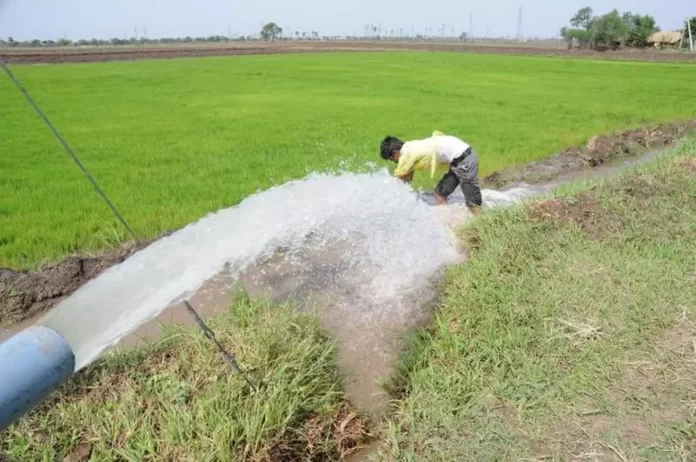Before India’s independence, agriculture was diversified, featuring a variety of trees, grains, and vegetables that supported ecological balance and created a healthy, varied food culture. This traditional system helped our climate, recharge groundwater, and fostered sustainable agriculture. However, modern agriculture in India has shifted toward monocultures and water-intensive crops like rice and sugarcane, which are less diverse and more demanding on water resources. This shift has introduced challenges for water sustainability and public health.
Ramesh Chand of NITI Aayog, in his 2021 report, highlighted India’s water inefficiency in agriculture, noting that the country uses 2-3 times more water per ton of crop than developed nations (Ramesh Chand, 2021). He advocates for practices like micro-irrigation, better crop planning, and diversified crop choices to improve water efficiency.
Total Usable Water
According to the Central Water Commission (CWC), India’s utilisable water resources amount to around 1,123 billion cubic meters (BCM), with 690 BCM from surface water and 433 BCM from groundwater. Agriculture alone consumes about 80% of this water, reflecting the sector’s heavy reliance on irrigation for water-intensive crops. The remaining 20% is used for domestic and industrial purposes (CWC, 2022).
1. Rice: The Water Challenge
India’s rice production for the 2023-24 agricultural year is estimated at 136.7 million metric tons (MMT) (Ministry of Agriculture, 2023). As a water-intensive crop, rice requires significant resources; each kilogram of rice needs roughly 2,500 liters of water (Water Footprint Network, 2023). This translates to an estimated 341.75 BCM of water for annual rice production. While agricultural efforts aim to improve water efficiency on farms, consumers also play a role in reducing this footprint.
Rice: Consumer, Entrepreneur and GST Policy Solutions
Dietary Diversification: Encouraging alternatives to rice, such as brown rice, millets, buckwheat, amaranth, and cauliflower rice, can save water. Organizations like the Nutrition Society of India could collaborate with celebrities to promote these alternatives, which not only require significantly less water but are also healthier options.
GST Initiative: By plotting health and environmental impact on the X and Y-axis, white rice—characterized by its high glycemic and environmental footprint—could justifiably be placed in a highest tax tier. In contrast, while brown rice requires the same amount of water per kilogram as white rice, it boasts a lower glycemic index. Brown rice is also more filling due to its higher fiber content, slower digestion rate, and greater nutrient density. These factors can lead to increased satiety, with half a cup of brown rice potentially satisfying hunger as much as a full cup of white rice. Theoretically, if India were to switch entirely to brown rice, water usage could drop to 170 BCM from the current 341 BCM as noted above. Therefore, a zero percent GST for brown rice would align with these benefits and serve as a logical incentive to influence consumer behavior. The GST council must consider both health and environment in its planning.
Vertical Farming: A private startup could take inspiration from Singapore’s “Temasek Rice,” a drought-resistant, semi-dwarf rice variety cultivated in small vertical farms with minimal water usage. The startup could innovate by exploring rentable rooftop spaces from homeowners or by promoting the cultivation of various rice varieties in pots, making urban rice farming both feasible and sustainable.
Startups can reform broken rice kernels: Professor Syed Rizvi from Cornell University developed a method to reform broken rice kernels into whole grains. The approach uses supercritical carbon dioxide to bind rice particles, making them look and perform like full grains while also enabling fortification with nutrients like proteins, vitamins, and minerals. The process is efficient and sustainable.
More on the topic: https://news.cornell.edu/stories/2013/03/new-method-makes-puffed-rice-pop-more-nutrients
2. Sugar: The Water Challenge
India’s sugar production for 2023-24 is estimated at 34 MMT (USDA Foreign Agricultural Service, 2023). Producing one kilogram of sugar requires between 1,500 (Jaggery) to 3,000 (Sugar) liters of water, translating to an estimated 51 to 102 BCM of water annually (Water Footprint Network, 2023).
In 2022, according to the World Population Review (sugar and sweetener consumption), India’s per capita sugar consumption was 17.04 kilograms, compared to China’s 7.91 kilograms. This disparity reflects both cultural preferences and the public health challenges India faces.
Sugar: Consumer, Entrepreneur, and GST Policy Solutions
Healthier Alternatives: Consumers can be encouraged to replace refined sugar with alternatives like jaggery, stevia, monk fruit, and erythritol. These alternatives require less water to produce, and the promotion of these options can be a healthier choice as well.
Startups Advancing Sugar Alternatives: MeliBio, USA, has partnered with Narayan Foods to bring its lab-grown honey to over 75,000 stores across the European Union. Meanwhile, Fooditive Group, a Dutch startup, uses upcycled apple and pear byproducts to create a sustainable sugar alternative through fermentation. India has the potential to innovate similarly by leveraging local grown fruits. This approach could align with global trends in health and sustainability while promoting local produce.
More on Melibio: https://vegnews.com/melibio-real-honey
Vertical Farming for Sugar Alternatives: Similar to rice, vertical farming could enhance the sustainability of sugar alternatives, providing a more water-efficient method of cultivation in urban spaces.
GST Initiative for Sugar: As with rice, all refined sugar-laden products could be taxed at the highest GST rate to drive consumers toward more sustainable and healthier alternatives.
3. Wheat: The Water Challenge
India produced about 112.74 MMT of wheat in 2022-23, requiring approximately 1,400 liters of water per kilogram. This equates to an estimated 157.8 BCM of water used annually for wheat farming (Ministry of Agriculture, 2023).
Wheat: Consumer-Driven Solutions
Dietary Changes: Promoting a balanced diet with lower consumption of wheat could help conserve water. Since wheat has a lower water use than rice and a minimal negative health impact, it might be eligible for a lower GST rate than rice.
Sustainable Wheat Varieties: Encouraging the use of drought-resistant wheat varieties that require less water to cultivate can also contribute to water conservation.
4. Cotton: The Water Challenge
In 2023, India produced about 5 MMT of cotton, which requires roughly 10,000 liters of water per kilogram. Including dyeing processes, this figure can reach up to 20,000 liters (Water Footprint Network, 2023; Cotton Association of India, 2023). Consequently, cotton production uses approximately 50 to 100 BCM of water annually.
Cotton: Entrepreneur and GST Policy Solutions
Lab-Grown Cotton: Innovative startups like GALY offer sustainable solutions, with GALY’s lab-grown cotton conserving 80% water and 97% land. This technology can significantly reduce the water footprint of cotton production while growing cotton ten times faster than on land.
More on GALY: https://www.freethink.com/science/lab-grown-cotton
Water-Wise Dyeing Technologies: In textile dyeing, technologies such as DyeCoo’s liquid CO₂-based dyeing and Colorifix’s microbial approach provide eco-friendly, water-saving alternatives. As lab-grown cotton and waterless dyeing technologies expand, farm-grown cotton and unsustainable dyeing processes could be taxed at a higher GST tier, while sustainable alternatives receive zero or lower rates.
A Sustainable Manufacturing Solution: Manufacturer’s can use plain cotton cloth for 20-30% of a sari, particularly for parts that remain hidden when draped making it a win-win on resource use and cost to consumers.
Circular Economy: Startups like Agraloop BioFibre are transforming agricultural waste into cotton fibers, which could reduce the environmental impact of cotton production. Another startup, Rubi Laboratories focuses on converting CO2 emissions into cellulose pulp using enzyme-based technology.
More on Rubi Labs: https://www.retailtouchpoints.com/features/news-briefs/walmart-and-rubi-labs-pilot-textiles-made-with-captured-carbon
5. Other: Challenges and Solutions
Lab-Grown Meat: India, a leading exporter of carabeef, must urgently explore sustainable alternatives given the significant environmental costs of traditional meat production, which requires approximately 15,400 liters of water per kilogram of beef. Lab-grown meat, such as the FDA-approved products developed by UPSIDE Foods in the U.S., offers promising solutions that minimize water and land use while addressing ethical and environmental concerns. Similarly, startups like Modern Meadow and Faircraft are pioneering lab-grown leather, while Mycoworks leverages mycelium to produce sustainable leather alternatives. These innovations are crucial, as traditional leather manufacturing heavily pollutes water systems.
Coffee: Coffee cultivation often leads to deforestation in critical water catchment areas such as hilly regions. Finland’s VTT Technical Research Centre has pioneered lab-grown coffee using plant cells, ensuring sustainable production.
Palm Oil: India should consider alternatives to palm oil before expanding its cultivation. Startups like C16 Biosciences are developing sustainable substitutes to address its water-intensive nature and deforestation impacts.
Paper: Traditional paper production in India contributes to water scarcity and land degradation. Innovative startups like Paptic (sustainable materials from renewable fibers), Papermelon (upcycled waste paper products), and MIT’s lab-grown wood project offer promising alternatives.
Rubber: BaCta, a Paris-based startup, produces carbon-negative natural rubber using engineered microorganisms. In states like Kerala, shifting from rubber plantations to Ayurvedic medicinal trees could restore soil health, replenish water tables, and address climate challenges.
Consumer Education: Campaigns emphasizing the water footprint of crops and health impacts of refined foods can drive informed consumer choices, supporting sustainable alternatives. Graduates of management and food science should work collaboratively with the government to create compelling messaging in all regional languages.
Use of Treated Wastewater: India treats only 20% of its wastewater, compared to the global average of 50%. Entrepreneurs can collaborate with municipalities to use treated wastewater for agriculture and industry, following successful models in Israel, the UAE, and Singapore
Conclusion
The four crops—rice, sugar, wheat, and cotton—consume nearly 700 billion cubic meters of water annually, about 60% of India’s usable water resources, worsening water scarcity and fueling public health issues like diabetes and obesity. A coordinated effort is needed: consumers adopting diverse, water-efficient diets, entrepreneurs driving innovations like lab-grown crops and vertical farming, and policymakers incentivizing sustainable practices through measures like differentiated GST rates.
Urgent action could save 150-200 billion cubic meters of water annually within 3-4 years, particularly through improved practices for rice, sugar, and cotton. This holistic approach conserves water, enhances public health, increases employment, makes more land available for growing trees, and boosts economic resilience, moving India closer to a sustainable, water-secure future.
References
- Central Water Commission (CWC). (2022). Annual report on water resources in India.
- Chand, R. (2021). Improving water efficiency in Indian agriculture. NITI Aayog.
- Cotton Association of India (CAI). (2023). Cotton production estimates for India.
- Ministry of Agriculture and Farmers Welfare. (2023). Fourth advance estimates of production of food grains in India.
- USDA Foreign Agricultural Service. (2023). India’s sugar market report 2023.
- VTT Technical Research Centre of Finland. (2023). Lab-grown coffee research: Sustainable innovation for the future.
- Water Footprint Network. (2023). Water statistics on agriculture. [https://waterfootprint.org].
- United Nations Water (UN-Water). (2023). Global wastewater treatment trends and statistics. https://www.unwater.org].
- World Bank. (2023). Reports on wastewater treatment and water management practices. https://www.worldbank.org].
- Israel, UAE, Singapore Water Management – Specific examples of wastewater treatment models from these countries are often discussed in sustainability and water management reports.
- World Population Review
- To learn more about startups. Check out: startus-insights.com, crunchbase, cleantech group.
Ram Ramprasad is a passionate advocate for sustainability. He has written many articles on sustainable strategies for well-known publications. Ram has also served as the Global Marketing Director for a leading multinational company in the USA. He holds degrees from Madras University in India and Yale University in the USA.











